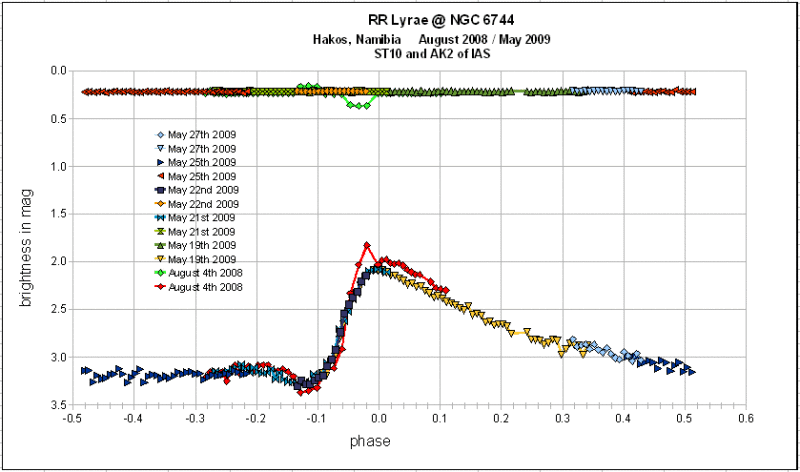| Article in PDF |
"Peremennye Zvezdy", Prilozhenie, vol. 9, N 22 (2009) |
A New RR Lyrae Variable Near NGC 6744 in Pavo
T. Sauer
Munich, Germany
| ISSN 2221–0474 |
Received: 7.06.2009; accepted: 25.06.2009
(E-mail for contact: ths12@t-online.de)
| ||||||||||||||||||||||
Remarks: |
| On August 4, 2008, the galaxy NGC 6744 in the constellation Pavo was imaged with
a 45-cm
telescope (the so-called Astrokamera 2, AK2) of the Internationale Amateur
Sternwarte (IAS) observatory in Namibia (about 130 km southwest of the capital Windhoek,
next to the guest farm Hakos: 23deg 14' 11'' south latitude and 16deg 21' 42'' east
longitude) in combination
with an SBIG CCD-camera (ST10) for 5 hours.
The exposure times for single images were 5 - 6 minutes.
These "pretty picture data" were fed into the Muniwin program, which indicated a
variable star to the north of NGC 6744, close to NGC 6744A.
The corresponding light curve is displayed red. Despite of distortions due to different
filters used for an LRGB-series of NGC6744, the typical shape of an RRAB light curve
can clearly be recognized.
In May 2009, this star was observed again using the same combination of telescope (AK2) and camera at the IAS observatory in Namibia. The exposure time was 5 min, and a blueblockage filter (transmission of 50% between 450 nm and 480 nm and 100% between 480 nm and 670 nm) was applied. Dark and flat field reduction was performed by CCDSoft and photometry, by MaximDL. For all curves, the same reference star was used: GSC 9075-00021 (19:08:52.94, -63:44:10.1, J2000, 15.21 mag). The upper curves show the brightness of the check star. After having obtained the complete light curve on May 25, 2009, the period could be determined using the data from May 2009 as 12.48 h. Using the maximum from 2008, the period could be refined to 12.47780 h (= 0.519908 d). |
Light Curve
Top: the light curves of the check star. Bottom: the light curves of the new variable from different dates. The red curve is the "discovery curve" from August 4, 2008. All observations were folded with the tabulated period. Finding Chart 
Size: 14.5' x 8.4'. NGC 6744 is approximately in 9' to the south. Data Source |